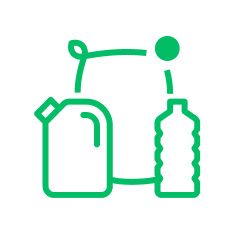Chemical solutions for all types of water treatment plants
Chemical solutions for all types of water treatment plants
Water is a necessary life element, a limited and fragile resource that is also essential for economical and industrial development. At Barcelonesa we are aware of this and that is why we provide you with specific products that help in the this resource sustainable management, ensuring the respect and compliance of the legislation.
In addition to offer you the suitable products for your needs, we offer you our formulation, waste management, storage, logistic and packaging services.
Specialized technical advice
Thanks to the experience, knowledge of the products and its application, our specialized technical team can offer you highly cost-effective technical solutions adapted to your needs.

Wide range of products and solutions
At Barcelonesa, we have a wide range of products and solutions and we have the capacity to make our own packaging and customized maquilas.

easyB: Technology at your service
We want you to spend your time on what's really important. That's why we have designed easyB; our online platform where you can easily manage your orders, consult/download all the documentation you need and consult our product portfolio.
Types of water treatment plants
Industrial Waste water Treatment Plant or WWTPI
Industrial Waste water Treatment Plants, also called WWTPIs, are plants that treat the waste water produced by one or more industries. These plants treat the water used in the different industrial processes that require special treatment processes due to their specific characteristics (waste, floating grease and oil, sand and coarse elements that the water may contain, both organic and inorganic decantable materials are eliminated and biodegradable organic matter dissolved in the water is also eliminated).
Usually, the industrial sectors where such plants may be needed are:
- Automotive sector
- Agricultural and animal farming industry
- Chemical and cosmetics industry
- Pharmaceutical industry
- Textile and tanning industry
- Paper industry
WWTPI Stages
For proper treatment, industrial waste water goes through different stages:
Homogenization of water
In this stage, processes to adjust the pH can be applied, as well as to separate the larger solids. This way, the solids from the company can be removed, obtaining a clarified waste water suitable for the following purification processes.
Physico-chemical purification
In this stage, the residual matter of the water is separated with coagulants and flocculants. Fats and suspended solids can also be separated by flotation or decantation.
Biological treatment
Depending on the type of water to be treated, different treatment systems will be applied. Through defoamers and nutrients, we can optimize the residual organic matter.
Sludge treatment
In the final part of the process, a system to thicken and dehydrate the sludge is installed. For this last stage of the process we can use flocculants or lime.
Chemicals for Industrial Waste Water Treatment Plants
Below you will find our range of specific products to be used in WWTPIs.
- Range BD DEPURFER
- Range BD DEPURAL
- Range DEPURGREEN
- BD SODAL
- Specific formulations
- Range BD Polifloc
- Range PH MINUS
- Range PH PLUS
- Depurcal
- Depurflow
- Range BD ANTISKUM
- Range BD BIOFOOD
- BD BLENDPHOS
- Depurcal

EDAR Industrial
Gama BD DEPURFER
Gama BD DEPURAL
Gama DEPURGREEN
BD SODAL
Formulaciones especificas
Gama BD Polifloc
Gama PH MINUS
Gama PH PLUS
Depurcal
Depurflow
Gama BD Antiskum
Gama BD Biofood
BD Blendphos
Gama BD Polifloc
Cal
Depurcal

Urban Waste Water Treatment Plant
Urban Waste water Treatment Plants or UWWTPs are very similar to industrial ones, except that they collect the waste water generated by the population, it is treated through a series of treatments and processes to finally return it to a receiving channel (river, reservoir, aquifer or sea). This type of treatment plants are in charge of eliminating contaminants such as:
- Thick objects such as pieces of wood, rags, plastics, etc. that are thrown into the sewage system.
- Sands
- Fats and oils
- Suspended solids of a very varied nature and origin. 60% of the suspended solids are sedimentable and 75% from an organic nature.
- Organic and inorganic easy oxidation components (they cause an oxygen comsuption present in the enviroment they are discharged into).
- Nutrients such as nitrogen and phosphorus originated by detergents and fertilizers.
- Pathogens that can produce or transmit diseases.
- Emerging contaminants, originated by personal care products, household cleaning products or pharmaceuticals.
UWWTP Stages
For the treatment of urban waste water, these goes through different stages:
Roughing
This stage removes small and medium sized solids that could damage or block the mechanical equipment of the next stages of the treatment plant.
Sieving
Suspended solids are reduced by filtration through a grating.
Primary Decanting
The purpose of this stage is to remove as much sedimentable solids as possible, under the exclusive action of gravity.
Biological Reactor
In urban waste water treatment plants it is necessary to add a process that includes a biological treatment with secondary sedimentation in order to eliminate the organic matter. This is carried out with the help of micro-organisms that act on the organic matter.
Secondary Decanter
In the previous process, flocculation takes place, generating aggregates of higher density. These aggregates are known as sludge or slurry and they are conducted to this subsequent sedimentation stage, where the sludge is separated from the effluent by the action of gravity.
Sludge Dehydrator
In the final stages of the treatment plant, secondary or biological sludges are generated. The part of water they contain is eliminated, transforming them into easily manageable and transportable solids. They can be dehydrated by centrifugation, band filters, thermal drying or drying areas.
Chemicals for Urban Waste Water Treatment Plants
Below you will find our range of specific products to be used in UWWTPs.
- Range BD DEPURFER
- Range BD DEPURAL
- Range BD SODAL
- Range BD DEPURAL
- BD SODAL
- Range BD POLIFLOC

EDAR Urbana
Gama BD Depural
BD Sodal
Gama BD Depurfer
Gama BD Depural
Gama BD Sodal
Gama BD Depural
Gama BD Polifloc


Water Purification Plant
Water purification plants are infrastructures responsible for eliminating microorganisms, parasites or substances that in a certain concentration may represent a risk to human health. In each country, the regulatory authorities are responsible for establishing the health and quality criteria for human water consumption and the water treatment plant is responsible for ensuring that these requirements are met.
Stages Water Purification Plant
In order to make water drinkable, it goes through different stages:
Collection
This is the process of collecting the water and is usually done through a set of electric pumps that raise the liquid to the loading chamber and then it is taken to the tanks. During pumping, the water passes through a series of grids of different sizes to retain as much solid waste as possible.
Coagulation
Once the water is in the tanks, all the particles are separated so that they float and can be removed more easily through the use of coagulants and flocculants. Solids are formed, known as flocs (flocculation), clots or lumps. During this process, algae and plankton in the water are removed.
Sedimentation
At this stage the water passes through a decanter where, due to gravity, the floc falls to the bottom of the tank to settle there and leave the water ready for the next stage.
Filtration
The water is conducted through a porous medium (sand and/or coal) in order to remove suspended solids in the water and to clarify it.
Disinfection
In this stage, organisms and pathogens that can cause diseases are removed by various methods, including chlorination. Once this last process has been completed, the water is ready to be consumed by the population.
Sludge Dehydrator
After the coagulation process, a sludge dehydrator can be added to transform the sludges into solids for easier handling.
Chemicals for Water Purification Plants
Below you will find our range of specific products to be used in purification plants.
- BD Oxitap
- Range BD DEPURFER
- Range BD DEPURAL
- BD SODAL
- Range BD POLIFLOC
- BD POLIFLOC MIDO
- Range BD CARBON
- BD HIPOWAT
Seawater desalination plant
BD Oxitap
Gama BD DEPURFER
Gama BD DEPURAL
Gama DEPURGREEN
BD SODAL
Gama BD Polifloc Mido
Gama BD Carbon
BD Hipowat
Gama BD Polifloc


Seawater desalination plant
A Seawater Desalination Plant (SWDP) or desalination plant is an industrial installation designed to remove salt from seawater in order to obtain, through a series of processes, drinking water. This water purification process is very costly in terms of energy, however, in some countries the need justifies the enormous energy consumption of this type of plant.
There are different methods to reduce the salinity levels of water (distillation, freezing, hydrate formation, flash evaporation or electrodialysis) but the most widespread is reverse osmosis. This technology makes the water pass through a series of membranes, applying mechanical pressure that counteract the natural osmotic pressure, causing the water to be transferred from the area with the highest concentration of salts to the area with the lowest concentration, purifying it during the process.
Desalination Plant Stages
In order to desalinate water, these goes through different stages:
Pre-treatment
The salt water is collected through several hundred metres long collector pipes located on the seabed. They are transported to the pre-treatment area where suspended solids are separated and sodium hypochlorite is added to remove the bacteria and micro-organisms.
Filtering
The water is passed through sand and coagulants filters such as ferric chloride, which help to sieve out the smaller particles that remain dissolved in the water.
Microfiltration
The water passes through special cartridge filters that contain Active Carbon and other products capable of retaining the remaining micro-impurities.
Reverse osmosis
This is the most important stage, making the water pass through racks that convert the salt water into fresh water. Mechanical pressure is applied to the more concentrated solution container, the water moves in the opposite direction, separating the salt during the process.
Post-treatment
At this stage the water is remineralized by adding lime and carbon dioxide to make it suitable for human consumption. The water is stored in special tanks, ready for distribution.
Chemical products for Desalination Plants
Below you will find our range of specific products to be used in Desalination Plants.
- BD Oxitap
- Range BD DEPURFER
- Range BD DEPURAL
- BD SODAL
- Range BD POLIFLOC
- BD POLIFLOC MIDO
- Range BD CARBON
- BD HIPOWAT
Looking for a specific product?
Through our easyB platform, you can see all the products we have available, download documentation and much more.

Quality
Certifications that guarantee that we comply with the highest quality standards in terms of products, services and management.

How can I help you?
Victor Hebrard
Sector Manager


